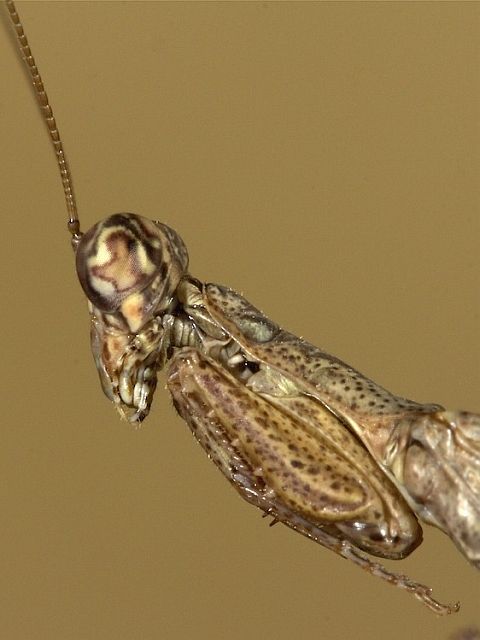Yes, in this species the sexes look very different.
So no objections and we can add it to the books
Another one done
Moderator: Klipspringer
Here is an Antistia species identified by an expertExFmem wrote: ↑Thu Dec 24, 2020 11:26 pm**********************************Klipspringer wrote: ↑Sat Dec 12, 2020 1:22 pmI think, this is not Tarachodes, butExFmem wrote: ↑Sun Jan 26, 2014 7:38 pm Bark Mantid Tarachodes sp.
Family Tarachodidae. Subfamily Tarachodinae. Tribe Tarachodini
There are 9 similar looking species found in South Africa.
Attracted to the outdoor light at KTC in KTP in Nov. 2013
Habitat
Usually on tree trunks in the warmer parts of the region. Range extends to Namibia and Zimbabwe.
Biology
Tarachodes sp. move about on the trunks of trees in search of caterpillars and other prey. Several African species show maternal care, with females guarding the egg case for up to 70 days until the nymphs hatch.
Body structure
Their head is triangular and extraordinarily mobile with large compound eyes set very high on the upper corners and three simple eyes called ocelli on top of the head (between the compound eyes).
Behavior
Most mantids sit quietly and wait for prey to come within reach, but a few species actually chase down their victims. After feeding, they always spend a great deal of time grooming. They use their forelegs to wipe their eyes, heads, and antennae.

Antisdia parvaor a Galepsus male

head of Galepsus here, page 40 - looks very similar in shape
http://verlag.nhm-wien.ac.at/pdfs/100B_ ... enbach.pdf

I can't find much info. at all on Antistia, but the few pics I see certainly appear very similar. HOWEVER, as I know only too well, that is in no way a scientifically valid ID component. As per my usual, I'll have to rely on your best judgement, and I certainly have no problem having its ID changed. Obviously, I can't read German, so most of that literature was not decipherable to me. Big help, I know, as per my usual. THANKS FOR ALL YOUR TIME AND EFFORT.




ID (Antistia) suggested by R. Ehrmannn; In the observation area only 2 species are at home, Antistia maculipennis and A. robusta, which are very much alike. It is not totally clear from my picture, which of them I have observed.
Obviously I can read German, but the science lingo of yesteryear is not really German. However - I understand the highlighted bits: A. vicina can be told from the other species in the Genus by the lack of dark patches on the the elytra. If you compare with the photos above, you can see the dark markings on the elytra, which your Antistia does not sport.Antistia vicina sp.n. (Abb. 22, 26, 182)
Locus typicus: Algeria Forestry, Südafrika.
Material: Holotypus (d): SÜDAFRIKA: Cape Province, Algeria Forestry, Clanwilliam Dist., 4.-
I0.III. 1969, Potgieter & Strydom, TMSA; Paratypen: 2 66 vom gleichen Fundort, TMSA und NHMW. -
NAMIBIA: 1 6. Plateau 38, Lüderitz, 16.- 18.X.1970, S.M. H 10054, SMWN.
Diagnose: (d; ç unbekannt): Antistia vicina sp.n. ist in Größe und Gestalt A. maculipennis ähnlich.
Frontalschild 1,7 - l,9mal so breit wie hoch, Frontalschild-Oberrand flach bogenförmig, Scheibe ohne medianem Querwulst.
Pronotum wie bei den anderen Antistia-Arten mit sehr schwach ausgeprägter Supracoxalerweiterung, 2,0 - 2,2mal so lang wie breit. Mediankiel nur angedeutet. Metazona 1,7 - 1,8mal so lang wie die Prozona, gegenüber dieser verschmälert, mit einer Querfurche im basalem Drittel. Pronotum-Scheibe flach gewölbt, Rand nur spärlich bewimpert.
Elytren 4,2 - 4,4mal so lang wie das Pronotum. Vordertibien mit 9-10 Außenranddornen. Schreitbeine stark pubeszent. Körperfärbung bräunlich, schwarzbraun punktiert. Elytren und Alae transparent, mit brauner Aderung, ohne dunkle Fleckenzeichnung im distalen Feld. Nur im proximalem Teil der Elytren ein kleines Flügelstigma.
Maße in mm: Long, corp.: 22,0 - 24,0; Long, pronoti: 4,2 - 4,3; Long, metazonae: 2,7 -
2,8; Lat. pronoti: 2,0 - 2,1; Long, elytr.: 18,2 - 18,5.
Differentialdiagnose: Von den drei anderen Arten der Gattung durch den höheren Frontalschild, die fehlende Flügelzeichnung und besonders durch den Bau des Kopulationsorgans gut unterscheidbar.
Again the "Längsmakeln" in the distal section of the forwing or the lack thereof and the spots on the hindwings. As the hind wings ("alae") are hyaline, the dark spots should be visible if present when the wings are folded at rest.3) Elytren im distalen Teil des Diskoidalfeldes mit einer schräg verlaufenden Reihe dunkelbrauner Längsmakeln (Abb. 23, 24). Diskoidalfeld der Alae distal mit dunkelbraunem Querstreifen; wenn transparent ohne dunkle Zeichnung ist der Pseudophallus kurz und gedrungen.
5(4) Alae des Männchen hyalin mit kurzem braunen Querstreifen (Abb. 23), der bei A. vicina Kaltenbach manchmal fehlt.
No, most members of this family mimic wasps others as yours are bee-mimics